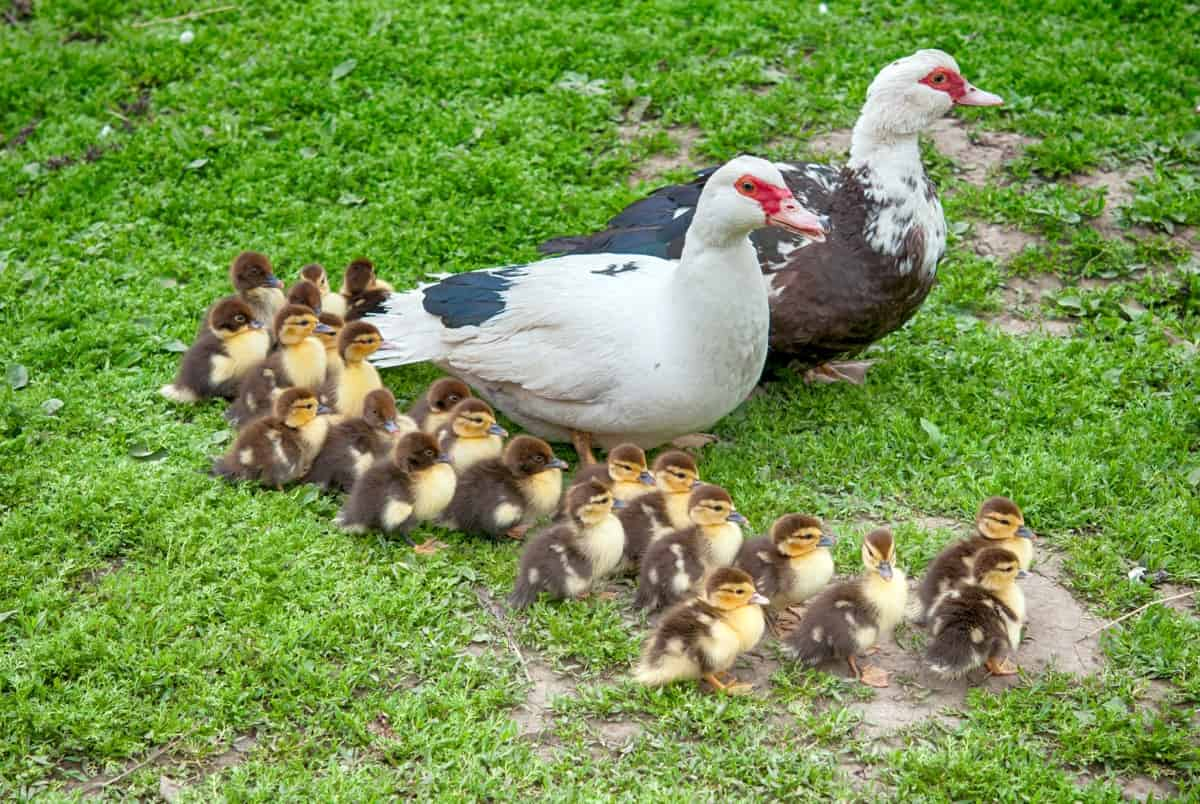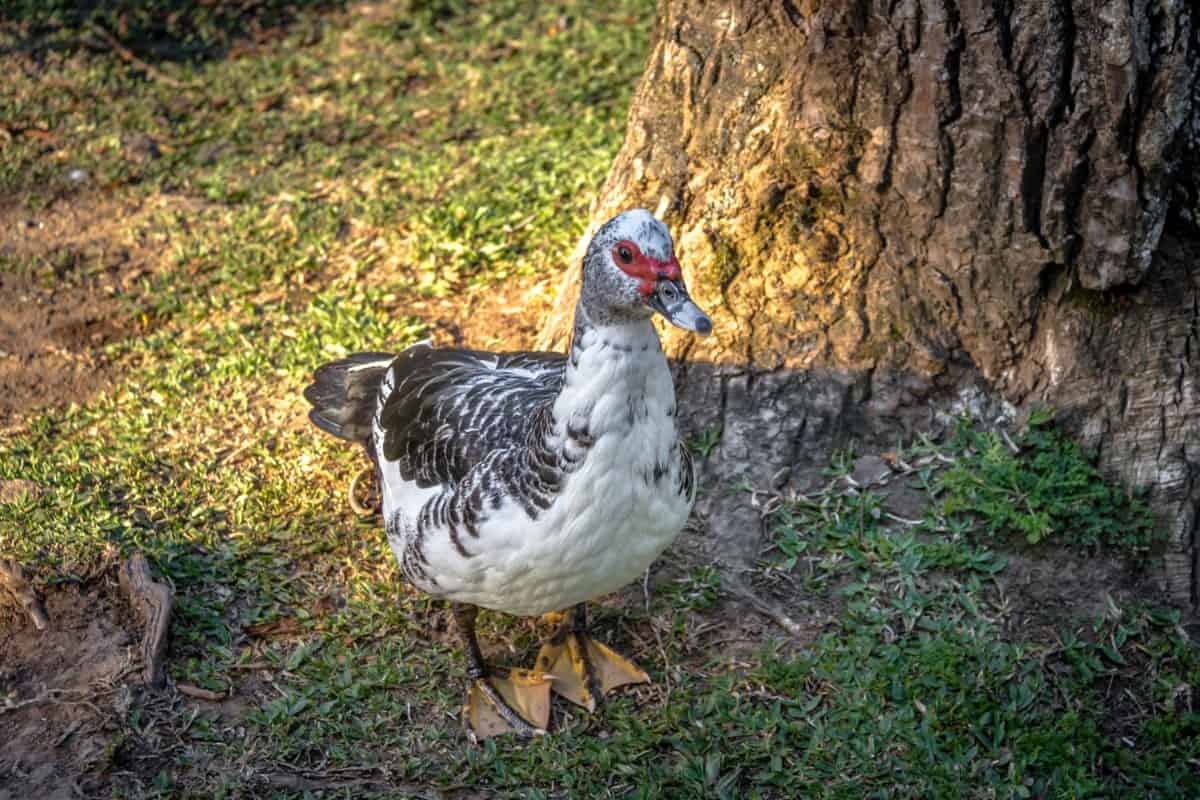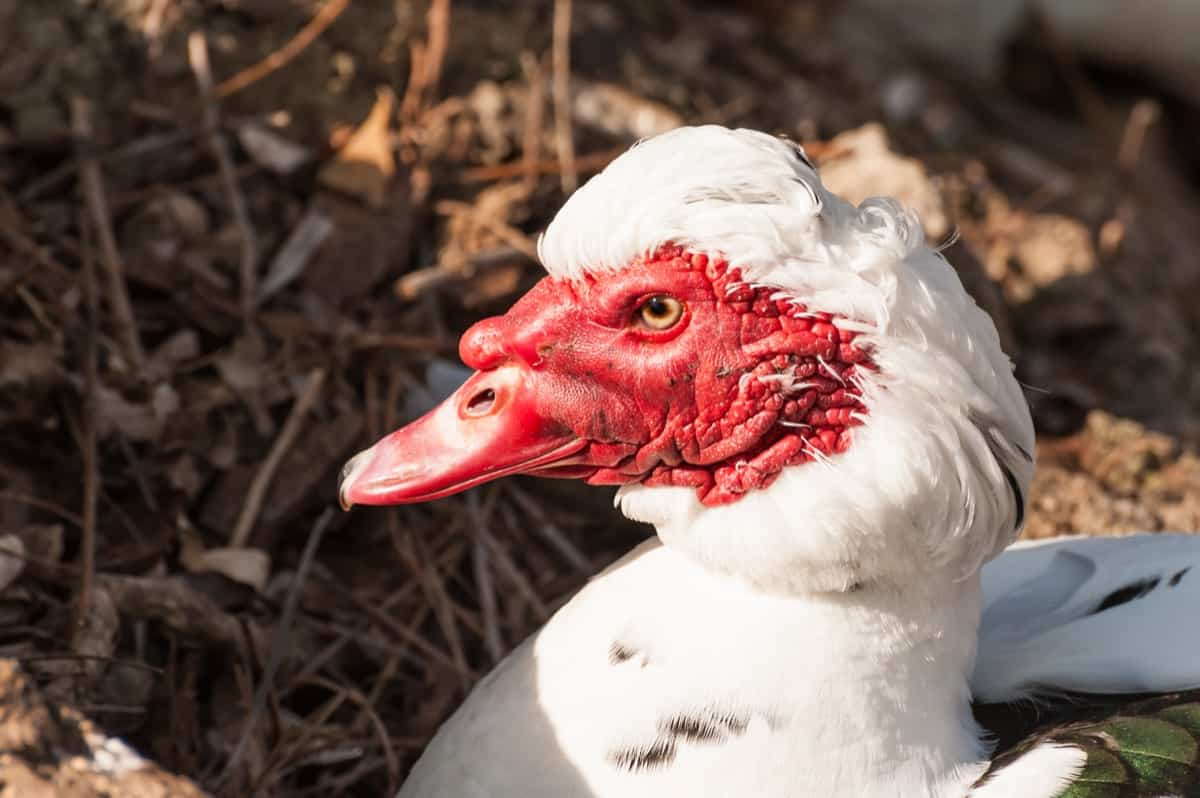In comparison to other ducks, the Muscovy duck is very different. Even though they are waterfowl, they prefer to spend their time roosting in trees away from predators. A Muscovy has many benefits on a homestead, including eggs and great pest control. It is easy to maintain, quiet and adapts well to chickens and other fowl. Even if you don’t have a pond or stream nearby, you can keep them. As a water source, a small paddling pool would be perfect for Muscovies. Here’s what you need to know about this unique duck.

Muscovy Duck Facts
Muscovy Duck Appearance
- Muscovy ducks are big ducks. Females are usually half the size of males and can reach a length of 30 inches.
- The wings of a wild Muscovy are mostly white with iridescent black patches. From black to white, domestic varieties can be found in various colors.
- Their bodies are solid and sturdy, with a long neck. They have a long, flat tail.
- Muscovy ducks are also known as greater wood ducks. In the wild, Muscovies live and perch in trees for safety. They grip branches with strong, sharp claws on their black webbed feet.
- An orange or black knob is positioned at the base of a long, sloping bill. In addition to pink, black, yellow, and combinations of colors, the bill can be other colors as well.
- There will be a mask on each Muscovy Duck. Face masks like this are actually called caruncles. These growths resemble knobby warts.
- These caruncles begin to grow as adolescents and will slowly grow throughout their lives. Males have larger and redder caruncles. The feathers contain oil glands that secrete oil for preening and waterproofing.
Muscovy Duck Egg Production and Broodiness
- The Muscovy duck usually lays about 16 eggs per clutch a few times yearly.
- There are about 190 cream-colored eggs laid by the Muscovy Duck every year. The eggs can weigh up to 75 grams and range in length from 1-2 1/2 inches.
- Generally, Muscovy ducks begin laying around six months, but some may not start laying until 71/2 months of age.
- When the weather is warm, Muscovies are prone to brooding and often gather as many as 16 eggs to lay.
- There have been instances of females brooding together or even co-nesting with chickens. They seem to be quite happy with the arrangement and enjoy the company.
- Muscovy Ducks are excellent mothers who incubate eggs for 30 to 35 days.
- Ducklings look yellowish with brownish markings when they hatch, and they will stay with their mother for 10-12 weeks.
In case you missed it: Top 10 Common Mistakes to Avoid in Duck Farming

Muscovy Duck Feeding
Muscovy Ducks are omnivores, which means they eat both plants and animals. They will also consume corn, grass, and grains. Like adults, they will eat bugs, slugs, insects, and crustaceans as they age. In addition to an all-flock feed, Muscovies can obtain tidbits from the yards and gardens to supplement their diets.
Pest control is excellent with them, and they will get rid of slugs, snails, and flies. It also attacks termite hills in tropical areas and eats the termites there. You can feed them extra greens such as chopped lettuce, cut grass (pesticide-free), chopped fresh veggies, and corn. When you have a pond, they dabble and eat some roots and plants.
Add around 10% more corn, oatmeal, peanuts, or peas to the food you feed muscovy ducks in winter. You may also want to consider providing calcium supplements. They should continue eating greens like cabbage, kale, and fruits as part of their regular diet. Bugs can also be added to the meal if you find them, though they may be hard to find in the winter.
Muscovy Ducks Coop Setup and Roaming Habitat
Unlike other ducks, Muscovy ducks prefer to perch, so roosts must be sturdy in the coop. Their relationship with chickens seems good, and they are not bothered by sharing the coop. Large chicken-style nesting boxes are ideal since chickens instinctively nest in high places. The ideal dimensions for a box would be two feet high, 18 inches wide, and 18 inches deep. It may be a good idea to leave the top of the box open if you have more than one Muscovy hen, as they like to co-nest together.
Streams and ponds are also great places for them to find tasty crustaceans, roots, larvae, and other goodies. They’ll eat grass too! They are great at removing grains and seeds in general. Although they will tolerate confinement, this duck does much better if allowed to graze outside the coop. Give them plenty of space if you must keep them in a run. Ensure they have at least 15 square feet of space and a wading pool for water.
Muscovy Duck Temperament
- A Muscovy duck is a friendly duck. When they are excited to see you, they commonly wag their tails and bob their heads, even though they do not quack.
- Their noises are more hisses and huffs, but do not consider they are hissing out of fear or anger; it is simply a way of expressing themselves.
- During breeding, males can be a bit of a handful, but females are generally calm.
- As the females are good flyers, you may want to clip their wings to prevent them from taking off for other areas. However, the drakes are too heavy to fly well or far.
- Unless trained as ducklings, they do not like to be handled, but they will get used to being touched and petted over time.
In case you missed it: Top 10 Common Mistakes to Avoid in Duck Farming

Some Interesting facts About The Muscovy Duck
- Due to domestication, Muscovy ducks originated in Central and South America but are now found in many other countries.
- Muscovy ducks are quiet; they don’t quack like other ducks. Unless they are attacked or excited, they are usually fairly quiet.
- There is a soft, trilling call from the females and a low, calm call from the males.
- Their tails often wag when they are unhappy, happy, or excited, and they can also puff or hiss when excited.
- A Muscovy can live up to 20 years in captivity, but they live on average 8-12 years.
- They are very hardy in terms of health. Colder areas may cause frostbite in birds with large or excessive caruncles, so keep an eye out for any problems.

Conclusion
Overall, this duck is friendly and enjoys human company. They commonly wag their tails and bob their heads when they are happy. Despite their slow maturation, they make excellent pest controllers and egg layers. Because of all these things, they are an excellent breed for a beginner.
- Feed Your Flock for Less: Top 10 Tips to Save on Chicken Feed
- Ultimate Guide to Ossabaw Island Hog: Breeding, Raising, Diet, and Care
- Hatching Answers: The Top 10 Reasons Your Chickens Aren’t Laying Eggs
- Eggs and Economics: Breaking Down the Cost of Raising Backyard Chickens
- Defend Your Greens: Proven Methods to Keep Iguanas Out of Your Garden
- Ultimate Guide to Cinnamon Queen Chicken: A Comprehensive Guide for Beginners
- Ultimate Guide to California Tan Chicken: Breeding, Raising, Diet, Egg-Production and Care
- Ultimate Guide to Marsh Daisy Chicken: Breeding, Raising, Diet, and Care
- 10 Types of Chicken Farming Businesses You Can Start for Profits